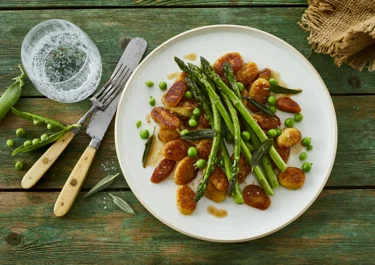
Gnocchi

Instructions
FAQ: Questions about gnocchi
Love gnocchi? We will help you become an expert! Our answers to your most common gnocchi questions will guide you in making them perfect every time.
Ingredients
Potatoes, boiled and peeled | 800 g |
|---|---|
Type 00 wheat flour | 150 g |
Coarse salt | 1 tsp |
Freshly ground pepper | |
Egg | 1 |
| 75 g | |
Sage leaves | 75 ml |
Lemon zest (unsprayed) | 1 tsp |
Peas | 250 g |
Grilled green asparagus | 200 g |
Flake salt |
Tips: Make the best gnocchi
Impress your guests with our easy recipe; read these tips that will help you make perfect gnocchi on your first try.
Gentle touch for perfect gnocchi
To ensure your gnocchi are as light as a cloud, handle the dough as little as possible. Resist over-kneading; a gentle approach is crucial. Mix the egg into the mashed potatoes and flour swiftly and gently to maintain tenderness. Add flour only as needed to avoid heavy dumplings, aiming for dough that is firm enough to shape but not too dense. Remember, when it comes to mixing and shaping, a lighter touch yields a more delicate texture.
Shaping the gnocchi
Forming gnocchi well is crucial as it affects both how they look and how you can use them in different dishes. Pressing ridges with a fork or adding a thumbprint is not just for looks; it helps the gnocchi hold sauce, making every bite more flavourful and helping them cook faster by increasing their surface area. Keep a consistent pressure when shaping them to ensure they cook evenly, and be careful not to make them too thick, or they might lose their lightness.
Try our easy gnocchi recipe
Potato gnocchi is an Italian classic, and in our recipe, the delicious dough balls are pan-fried to a golden crisp in sage butter. Complemented by fresh lemon zest, peas, and tender grilled asparagus, this recipe elevates simple ingredients into a dish that is sumptuously satisfying yet easy to prepare. Perfect for any meal, our easy gnocchi will impress anyone with a taste for Italian cuisine.
For more delicious recipes, check out these Hasselback potatoes, roast potatoes, and rosemary roasted potatoes.
Pillowy texture with a crispy crust
Our gnocchi boast a wonderful texture that is smooth and fluffy on the inside with a crisp, golden outer shell. The contrast between the soft interior and the crunchy exterior makes each bite a delightful surprise. It is the perfect texture for enjoying the buttery richness of sage butter, the slight crunch of fresh peas, and the delicate crisp of grilled asparagus.
Buttery notes with a hint of zesty lemon
Infused with the richness of butter and brightened by a hint of lemon, our gnocchi recipe hits all the best flavour notes and aromas. The butter lends a creamy, melt-in-your-mouth quality that is offset by the delicious zestiness of the lemon, lifting the dish delightfully to balance everything out. This combination ensures that the gnocchi, while rich, remains light and invigorating on the palate.
A cherished Italian potato dumpling
Gnocchi, a popular and beloved staple of Italian cuisine, are small potato dough dumplings. They are a testament to the simplicity and richness of Italian cooking, typically made from potatoes, flour, and eggs. The small dough balls serve as a versatile base for a variety of sauces, from this recipe’s classic sage butter to rich meat ragù. You can enjoy them as an appetiser, a main dish, or even as a side, showcasing their remarkable ability to adapt to different tastes and occasions.
What goes well with gnocchi?
Gnocchi is delicious with various sides and sauces. The simplest choice is to make a delicious sauce, for example, a tomato sauce, or drizzle homemade pesto over it for a green burst and delicious flavours.
It is also a good idea to serve it with light, fresh salads with a tangy dressing or vinaigrette to cut through the richness. Choose, for example, salad ingredients like rocket, spinach, or mixed greens with additions like nuts, dried fruits, or shaved Parmesan.
You can also serve it with roasted or grilled vegetables like asparagus, as we do in this recipe, peppers, courgettes, or cherry tomatoes to add colour and a smoky or sweet counterpoint to gnocchi’s mellow, delicate flavour.
Serve gnocchi with simple grilled or roasted meats such as chicken, pork, or light fish to complement it without overpowering it, as well as a side of crusty bread or garlic bread to absorb the buttery sage sauce.
Experiment with the recipe
Stir finely chopped kale or Swiss chard into the gnocchi dough to infuse it with a vibrant burst of colour and a subtle earthy tone that is delicious against the potato base. Or introduce a smoky dimension by incorporating smoked salt or a hint of smoked paprika either in the dough or the sauce. This subtle smokiness pairs exquisitely with the creamy gnocchi texture, adding an unexpected twist.
For those who enjoy a bit of heat, spice up the sage butter sauce with a dash of chilli flakes or a spoonful of harissa paste. You can also add caramelised onions or garlic to bring a depth of flavour. The sweetness of the caramelised ingredients melds with the savoury notes of the sage butter.
Even though sage is delicious and goes so well with traditional Italian flavours, you can experiment with different herbs. Use fresh herbs like marjoram, tarragon, or dill instead of traditional sage, with each herb either subtly or distinctly changing the character of the gnocchi, from the slightly sweet and citrusy notes of marjoram to the anise-like sharpness of tarragon.











